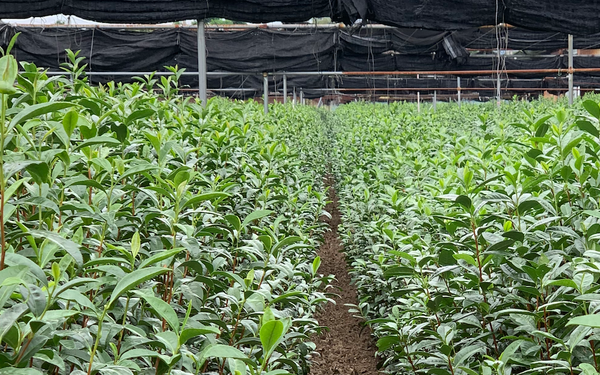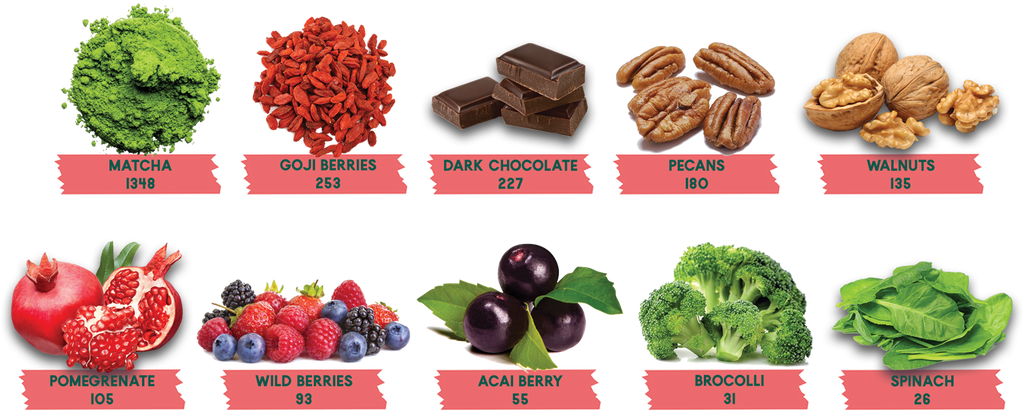Ultimate Guide to Matcha Green Tea, How to Prepare Matcha and Identifying Best Matcha Tea
Introducing Matcha
You might already be into caffeine drinks, but something you’ve likely noticed is the growing revival of Matcha tea. This specially powdered green tea has exploded with interest over the last couple of years, originally found only in Japan.
Wellness bloggers, foodies, and the health and wellness communities are also drinking matcha green tea more everyday to optimize their health – even bringing novelty (and antioxidants) to fun desserts and other recipes.
Even the millennial generation has found matcha’s amazing health benefits, not to mention a superior energy boost. And as more people replace their regular caffeine staples (coffee, energy drinks) with a daily matcha elixir, an influx of questions have begun to stir.
People are wondering about the health benefits, how it’s used, and what makes it unique compared to regular green tea. Many also want to know why it doesn’t interfere with sleep the same way as coffee, and what makes it such a dense source of nutrients compared to other teas.
Ready to learn more?
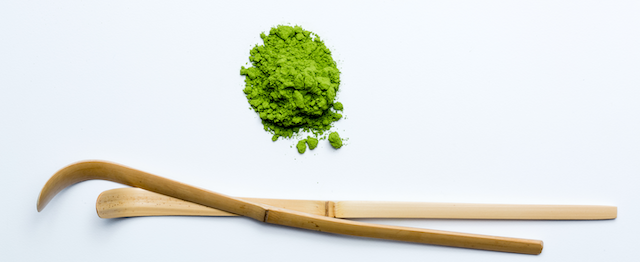
Matcha is very labor-intensive to produce and only a small amount is made each year. Most of the best matcha stays in Japan for domestic consumption, and few authentic tea farms have arrangements to export the higher qualities internationally such as to the U.S.
Although in limited availability, this rare form of powdered tea is exceptional for its versatility, and as a concentrated source of antioxidants and brain-boosting amino acids. For these reasons, more people everyday find matcha as the perfect alternative to coffee and sugary energy drinks – packing a punch that energizes you all day, without the crash.
The surge in popularity is exciting but is not without a lot of questions. Probably the most common one asked, “What’s the big deal with matcha?”
There’s a lot more than meets the eye, and that’s why it was time to put together this Ultimate Guide to Matcha.
Especially since not everyone knows how to get started, and many still don’t quite understand the differences between culinary and ceremonial quality, for example. It’s an expansive topic, but this guide will get you ready to jump right in!
Ready to matcha?
What You’ll Learn
This guide covers the most prized matcha growing regions in Japan, including facts you can count on as you navigate this emerald green world (why is matcha green?). Rest assured, you’ll learn about the range of qualities to look for, what a ‘grade’ of matcha means, and how you can identify the differences – sort of like fine wine.
This guide is guaranteed to give key pointers as you jump into the savory and aromatic world of this prized form of green tea. We’ll clue you in on the importance of high quality, premium matcha – where it gets its calming ‘Zen-like’ effects from – and why quality is more important than ever to help preserve ancient tradition.
Keep reading as we also cover some of the most surprising but important benefits matcha will have on your overall health and wellness. First up – the MOST common matcha questions:

Answering Your Common Matcha Questions
Authentic Japanese matcha is the ultimate form of green tea.It is shade-grown, carefully harvested, and stone-ground to become a fine powder.
- It has been the drink of choice for centuries for Zen monks (even the Samurai!).
Over the years, it has remained an ideal means of daily fuel, also known as a daily ritual (see Tea Ceremony) to help you feel grounded.
What’s the History of Matcha?
Matcha is the product of an ancient lineage of tea-farming. It was first brought to Japan around 1190AD; the Buddhist monk Eisai was the first to bring the practice of powdered green tea from China.
As an object of mindful practice in the cultivation and precise grinding of the tea, it wasn’t long until it became a uniquely Japanese beverage – one which transformed the political and monastic circles.
The prestige of its cultivation and preparation was originally enjoyed by the highest class of society. Tea masters, often leaders within Zen Buddhism, were honored with the role of administering the Japanese Tea Ceremony (Chado) within the political circle.
- Eventually matcha was in every nook and cranny of Japanese living, and today internationally!
In many ways, we see the practice of matcha drinking as synonymous with the ancient practices of the Zen Buddhist school; the preparation of matcha may be used in many ways, including for intense focus, enjoyment, and (when consumed) a heightened awareness conducive to meditation.
This amazing health drink we cherish today was only one of the many prolific transfers of knowledge, agriculture, and even religious practices across this time-period of Eastern Asia. We see the long, fruitful history with ancient roots dating back more than 1,500 years ago in China.
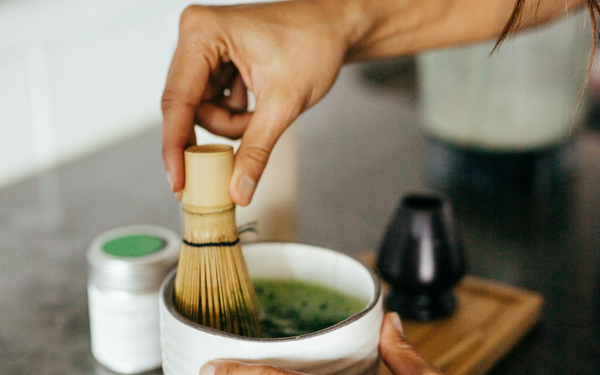
When did Matcha become Popular?
The matcha we know today began closer to 1,000 years ago in ancient Japan, a term coined by the literal translation of “powdered tea.” The driving force was Zen Buddhism, at the time it was a strong force of Japanese life.
They crafted an entirely new practice and even bred their tea-plants to possess superior characteristics of flavor and calming-effect, enjoying the powdered green tea with one another.
- Together, they enjoyed uplifting, yet calming effects – perfect for long periods of seated meditation.
A Focus on Quality
Over time, tea-farmers gradually selected certain qualities of taste, color, and calming effects as they honed other cultivation techniques. Harvesting methods became more complex and began incorporating shade into the pre-harvest environment.
Tea growers realized that shading during the right time of the season developed higher levels of focus boosting amino acids, improving the flavor, reducing bitterness, and yielding high levels of strong antioxidants and calming amino-acids.
Where is Matcha Grown?
Tea growing areas quickly gained hold of key areas of Japan, suited because of climate and pure landscapes. Many tea-farms had sprung up across the set of islands that make up the Japanese homeland, but the culture of matcha tea continued to grow strongest in the hillsides of Uji, Kyoto, where it first took root in Japan.
Till this very day, matcha can only be produced in Japan. Areas like Uji, Kyoto possess the perfect mix of climate and altitude for matcha tea and is where the most prize-winning tea-growers choose to cultivate this healthy drink.
- Our tea-farm is one example that has a lineage of family-ownership and careful land management for hundreds of years.
- It is one of only a few remaining farms true to the original culture of quality in Japan.
Do I have to use Matcha in a Ritual?
Zen practitioners realized that matcha boosted their memory and focus, which steadily gave rise to the Japanese Tea Ceremony. Although less common it is still practiced today. Matcha however has become much more modern, used in recipes, exotic lattes, and even quick preparations using an electric frother.
Modern enjoyment has followed in suit with a range of ways to enjoy this special tea, and no longer do you have to set time aside for a daily ritual, although welcomed by many, you’re free to make your matcha lifestyle fit your own personal needs.
YOU’VE BEEN WONDERING: WHY DRINK MATCHA?
Daily matcha drinking is pioneering new generations’ sense of wellbeing, focus, and concentration (sometimes called flow-state). It’s popular as an aid to modern meditation and mindfulness strategies and widely recommended by physicians for many potential health benefits.
Compared to green tea which is grown across the world, chemical analysis provides that matcha from Japan is in a separate class from regular green tea.
- The specialized farming techniques produce tea leaves used in matcha, containing more than 100 times the antioxidant compounds as traditionally steeped tea leaves.
- Shading conditions allow for more robust amino-acid content.
- Traditional methods make matcha green tea extremely rich in vitamins and minerals.
Matcha green tea is without parallel, it’s the most abundant natural source of the potent antioxidant ‘Epigallocatechin gallate’ (EGCG). Also, one of the amino-acids specifically that matcha is known for is called L-theanine, a savory, neuro-regulating amino-acid which is reported for cognitive benefits [1-3].
- It’s a ‘non-essential’ amino, not required to survive – but with it – you can thrive.
- L-theanine also has an exquisite and versatile umami (savory) flavor.
- Often thought akin to truffle sauce, or aged cheeses.
The extraordinary composition is owed to carefully managed cultivation and harvesting practices. Each authentic tea field has a tea-master who has learned the Way of Tea (chanoyu) through an intergenerational family lineage.
- Closely guarded techniques are passed down over the years and are responsible for those elevated levels of important health compounds.
How is Matcha Different from Green Tea?
Matcha comes from Camellia sinensis, the same tea-plant as green tea. However, unlike green tea and other loose-leaf teas, matcha is the only form of green tea where you consume the whole-leaf. In fact, the way it’s grown also, actually changes the chemical composition of the leaves.
This is how that same plant is also able to produce other teas, e.g. white tea, black tea, oolong, and pu-erh, which receive low levels of shade. Matcha on the other note requires careful hand-selected treatment, and precision shading, traditional soil fertilization.
- The age of the tea plant is also critical (usually at least 30-50yr of age), as is the manner of plants’ handling.
- Through each growth stage, gentle hands groom and care for leaves
- This serves the production of concentrated, healthy antioxidants and amino-acids
Is Matcha Better for You than Green Tea?
Traditional cultivation also produces more chlorophyll, thus enjoying the powdered form means an excellent source of all the healthy compounds and nutrients. Regular steeped tea (like the common green tea bags) don’t compete since many of those benefits are tossed with each bag after brewing.
Matcha leaves are also hand-selected, processed with light steam, and then dried. Here, the tea master chooses and categorizes the qualities of each leaf so they can be appropriately mixed and stone-ground to a final blend – can regular green tea speak to that intense journey?
Should Matcha be Stone-ground?
Authentic processing is practiced at only a couple handfuls of remaining matcha tea farms in Japan. This includes the use of a stone-mill which makes the matcha an extremely fine particle size. This process is one of the most important reasons that matcha is different from green tea.
Ideal to dissolve into the water for a hot tea, or into a cold-brew, unfortunately such stone-grinding has been mostly replaced by industrial grinders (blenders) all while authentic matcha grows harder to procure and protect.
All of our matcha is stone-ground, unlike quick processing, this method preserves the great taste of the matcha powder – its amino acids, its antioxidants – all of which otherwise are damaged by oxidation and microscopic heat of industrial processing.
Furthermore, stone grinding is the only means to effectively reduce the entire leaf to a uniform, microscopic particle.
- Industrial methods leave stems, and larger particles, making a gritty texture when consumed.
- Stone milling is invaluable to preserving desired qualities – making for maximal enjoyment AND absorption – and cannot be overlooked.
I've heard a lot about Health Benefits?
Green tea was first mentioned thousands of years ago in Traditional Chinese Medicine. Also, unlike coffee which is only centuries-old, green tea is dated well into the BCE.
Once it made it to the novel practice of matcha in Japan, those reported health benefits assumed a form of their own. The far improved health boost compared to regular green tea was thought to boost longevity, vitality, and immunity.
In recent years, research supports claims of anti-inflammatory, anti-carcinogenic, fat-burning , and neuro-regulating benefits [4-7].
- Skip to the full list of health benefits?
Another health distinction between brewed (steeped) green tea and matcha powder is that the entire leaf is consumed. Your body is free to absorb the whole composition – vitamins, minerals, amino acids, antioxidants – nothing is lost to a tea bag.
- Matcha is also a subject of novel medical research surrounding the entourage effect, describing the relationship of natural compounds when consumed through whole-food sources in the diet.
What's the difference between Culinary and Ceremonial grades?
When comparing the different grades of matcha, there are three (3) categories to be mindful of. The lower qualities also have more tannins (common in coffees and wines) in place of other healthy antioxidants, though both groups have good-for-you properties.
Here are more specific differences:
-
The highest quality is known as ‘thick tea’ or ‘koicha’, the type of matcha typically associated with the tea ceremony, and is typified by very little bitterness and sweeter notes.
-
Second, is ‘usucha’ or ‘thin tea’ which is a drinking grade of matcha. Excellent when prepared at a lower concentration, which accounts for higher levels of bitter notes and astringency, while enjoyable for aroma and vegetal flavor.
-
Third, is culinary grade matcha, a low cost, and more bitter flavor tea. This is matcha powdered produced from more mature tea leaves that haven’t received the same levels of individual treatment or careful shading.
How Long will Matcha Keep?
Matcha is best enjoyed closest to its processing date. Choose a source that routinely imports fresh batches, ensuring that no tea sits on the shelf for too long. When well kept, matcha doesn't technically spoil, but there’s always a chance of natural degradation over time.
- You should be sure that your matcha is kept in an airtight, light-proof container – preferably in the freezer.
- This method will slow the rate of oxidation, providing about 45-90 days to fully enjoy your matcha after opening the container.
No practical method will entirely protect the tea from air exposure, but enjoying the tea within this time frame will give you the best results, and the greatest enjoyment.
Does matcha contain caffeine?
Matcha green tea is naturally caffeinated. Each serving contains between 25-45mg of caffeine.
That's about 1/3 the cup of coffee, but because you consume the whole leaf, the effect is more of a time-release compared to coffee.
Best yet, people who make the switch report a need for less total caffeine, while the energy lasts longer – usually about 4-6 hours. The long-lasting energy is partly explained by L-theanine, which synergizes with the caffeine to produce a balanced energy release [8].

Another reason is a chemical variation of the type of caffeine the tea-plant produces.
- All caffeine is from a category of organic compounds called ‘xanthines’. This group of bioactive molecules has strong effects on our nervous system.
- This relationship involves the nucleobase, purine, a building block of DNA that xanthines closely resemble.
- Xanthines have been found in meteorites, begging the question of matcha’s energizing origins from outside the planet.
It’s notable that matcha green tea contains other stimulating xanthines. Those include theobromine and theophylline [9], compounds that are reported to work in boosting memory and learning, giving matcha a competitive edge against synthetic energy drinks.
Will I like Matcha?
Rest assured, matcha is an amazing change of pace for any lifestyle. We back all of our products with a 100% satisfaction guarantee. If you have a poor experience for any reason, let us know right away and we'll make it right.
Are There Different Types of Matcha?
As we first mentioned, people new to matcha see a lot of conflicting information. One of the most popular questions is, ‘why’s it different from regular green tea?’ There’s a LOT to unpack here, it goes far beyond the simple fact that it all comes from the same plant.
It has a lot more to do with how it’s grown...
Why there are Different Grades of Matcha
The excitement in the air right now has to do with the potential health benefits of matcha. Especially how they outweigh normal green tea. People are told to look for ‘Ceremonial Grade’ matcha, but without many pointers about differences, how are we supposed to identify it?
The term ‘ceremonial’ actually comes from the original role of matcha tea in ritual settings in ancient Japan. This is a ceremony that began nearly 1,000 years ago and has been prized ever since (first by Royalty and Zen Masters, now you!).
What’s more, is that the use of this special tea had strict guidelines for the flavor and effect these rituals were meant to evoke:
- Tea-masters quickly realized that not all tea-leaves were fit for the ceremony, but that didn’t mean they were useless.
- Each year, through careful growing conditions and ancient technologies, tea-growers are able to yield tea leaves which cover a range of qualities.
Of these, only the best, greenest, most flavorful ones would make it to use in ceremonial settings. The rest is generally reserved for culinary or medicinal uses rather than daily drinking.
Differences in Grades of Matcha
Due to the less savory flavor of culinary grade, it’s typically used for culinary purposes as it’s name suggests (e.g. cooking, baking, exotic meals). In these uses it’s not a primary flavor, which allows balance to the bitter and astringent flavor qualities.
As quality goes up, the vibrant green color does as well. The same may be said for levels of L-theanine, that savory amino acid which serves to counteract the bitterness.
- Lower quality matcha is subject to less shading, where sunshine triggers the production of more tannins, rather than preferred amino acids.
- Tannins are a type of antioxidant that attach to free radicals in the body, which reduces oxidative stress.
So, there are benefits on both sides, but less enjoyable flavor in the lower grades, and perhaps less of that ‘zen kick’ of calming focus from the amino acids.
CEREMONIAL GRADE MATCHA
Half of the matcha equation has to do with Ceremonial Grade, and is more often than not the quality most people are after. Ceremonial grade matcha powder has been used for nearly 900 years in the sacred setting of the Japanese Tea Ceremony, subject to tight regulations of what constitutes satisfactory quality, characteristics, and even color.
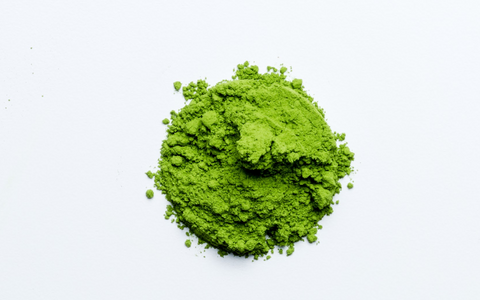
This is matcha which also must be processed in a specific way. The use of slow, stone-grinding preserves the nutrients and quality of the tea while making it into an extremely fine powder. The absolute highest tier of ceremonial grade is ground by hand, to ensure no loss of value or calming effects.
This is also the quality of tea that (at least traditionally) would be consumed plain. No sugar, sweeteners, or milks of any kind.
- The formality is more relaxed now, and international interest means all qualities of matcha are being used in a variety of preparations.
- Some may even use ceremonial grade in baked goods, but such cost is prohibitive to the average baker, however stunning the taste may be.
Most commonly though, this tea is still consumed plain. Here in the U.S. people are learning to properly prepare the tea with just the right temperature of hot water.
Finding a very tranquil effect, with an onset beginning just minutes after it’s enjoyed.
CULINARY GRADE MATCHA
Unlike ceremonial grade matcha which is crafted from the most elegant, youngest tea-leaves, culinary grade matcha requires less strict growing conditions and much less labor. It’s also not guarded as closely as the high-cost of ceremonial grade, giving many people flexibility in different uses.
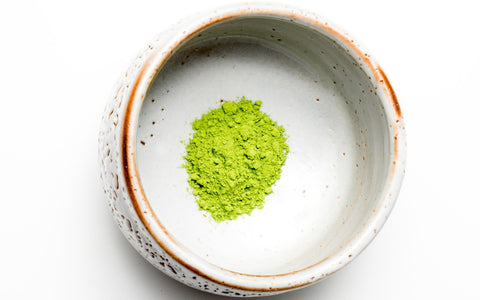
Culinary matcha is best served as a flavor in cakes or common desserts. It also does well for many cafes that serve a sweetened, milky type of matcha latte. In this case, it’s critical to beware of the high levels of sugar being added; some cafes will order very low-quality culinary grade (yes there is a range of quality, even for a culinary grade), and pass it off with an extra serving of sweetener.
CATEGORIES OF CULINARY MATCHA
So being mindful of the culinary grades that you’re drinking (or eating) is still important. There are five categories of culinary matcha that you can learn about and better recognize.
- The first one is a premium grade, which ideally would be used in those crafty lattes:
- The second is cafe grade, while decent, may require an extra pump of liquid sugar.
- Similarly, the third category is ingredient-grade, which as the name supports, would be ideal as one of many ingredients in sweets, cafes, muffins, or maybe even a horchata.
Finally, there is classic-grade matcha and kitchen-grade matcha. Like the other three, these are representative of a different cost point and flavor than ceremonial grade matcha. And while there is some overlap in how they all are categorized, these would do best in any preparation including them as secondary ingredients.
- In any of these cases, you want to avoid the culinary matcha being the primary flavor, just as you would avoid eating something super sweet or overly bitter.
Traditional Matcha: Protecting an Ancient Ceremony
Matcha’s popularity is still in its infancy outside of Japan, though it’s grown popular in the U.S. and other western countries, including Canada. This international demand is now rising exponentially and placing pressure on Japan’s annual capacity to grow matcha.
As demand is projected to continue rising, the sudden influx has also created infrastructural, even cultural threats to the long lineage of authentic matcha. Below we cover things to look out for, and how to make sure that the matcha you choose is cultivated ethically, and sustainably, so we all can continue enjoying real matcha!
Common Question – Is Matcha Fair Trade?
Originally countless, less than 60 traditional matcha tea-farms now remain in Japan. These few handfuls are the exception which have been able to maintain authenticity and the many centuries of premium ceremonial quality matcha tea.
And for the others, corporate interests have leveraged economic needs to industrialize tea farms into lower-qualities and higher-yields.
Long lineages of tea farming families have been forced now to supply poor quality, less labor-intensive green tea powder.
- Most of this is not, in fact, matcha, but a machine processed (not stone-ground) powder, often produced from second or third ‘flush’ tea leaves.
- Forcing the tea plants to produce more than one annual yield (i.e. first harvest) causes stress to them – many which approach or exceed 100 years of age – and may not recover.
This is green tea powder uncharacteristic of premium matcha; less vibrant and flavorful (and can be extremely bitter), all while reduced concentration of nutritional benefits.
Big Box Coffee Chain Matcha
The gap in quality hasn’t stopped corporate interests – i.e. ‘big-box coffee chains’ – from taking advantage. Marketing efforts have targeted those with no experience with real matcha and who are unwitting to the significant differences.
Now across America, many retail cafes have matcha offerings crafted from poorly graded matcha.
- This matcha is almost always disguised.
- It’s pre-blended as a sweetened (worried about sugar?) latte powder in order to hide the bitter bite.
- These cafe outlets are selling an imitation matcha at a premium cost point.
Unfortunately, tea-farmers have little choice in the face of corporate pressures. These families are forced to supply low quality matcha and sacrifice principles of purity; machine processing is brought in which removes the hand-picked quality, and introduces heavy metal contamination and petrol pollutants.
Ultimately the shift to a lower-quality matcha has meant the gradual loss of generational knowledge passed down at these family-owned farms.
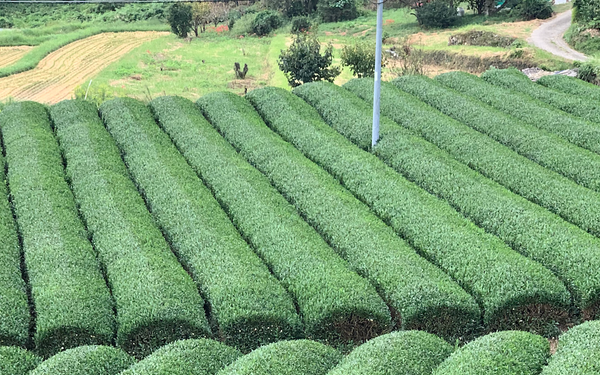
Does it Matter where Your Matcha is Grown?
It’s true that coffee houses and retail chains source that poor quality at a cheap price, sugar it up, and pass it off as the real thing. Even with additives, it’s common that people’s first experience with matcha is distasteful.
Many newcomers also report nausea or headache. We review why this should be unexpected of real matcha in our frequently asked questions. While such reports signify mounting evidence of these matcha offerings as non traditionally sourced.
It’s more essential than ever to note that if it’s not grown in Japan, then it isn’t matcha. While some ‘big box’ coffee shops do bring their matcha from Japan, a number of sources inform us that these chains are increasing their supply directly from China, even areas of Africa. The gist is that sourcing is more dubious than ever.
Even an unnamed ‘pastry pitstop’ near you has recently joined the matcha map, with greater doubt to where all of this matcha can be from – there is only a limited annual supply and most of it stays in Japan.
Is My Matcha Real?
For your matcha to be truly authentic, producers need to use a grade of tea leaf called ‘tencha.’ This is a costly form of whole-leaf tea which is grown under pristine conditions. Most matcha at your local cafe chain is unwilling to cut profits to import matcha tea powder made from this grade of leaf.
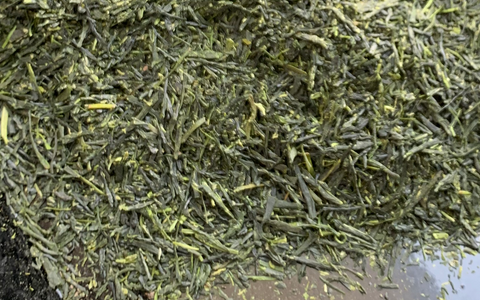
So, we see how there are more reasons than ever to be cautious. Understanding the risks of imitation matcha is a precedent to making wise decisions in your matcha ritual. And choosing your matcha source wisely is pivotal in sustainable tea-farming in Japan.
Real matcha should always have a vibrant green color and natural depth of flavor, and aroma. With artisanal characteristics in mind, you may more easily choose trustworthy, traditionally harvested matcha.
And in doing so, we may fight back by avoiding tea from farms that have replaced heirloom tea plants with mono-crop production.*
*Some which have also turned to industrial means such as gas tractors and petrochemical pesticides. That’s bad news for preserving tradition.
What are the Steps to Craft Ceremonial Matcha?
There are a handful of essential details that work behind the scenes to craft your favorite matcha. Tea masters use techniques passed down over countless generations (literally hundreds of years), which allow them to carefully control the growth of the tea leaves.
They delicately protect against excessive sunlight by providing intense shading – especially during the time leading to harvest. Furthermore, they specially amend the soil with traditional fertilizers, leading to authentic matcha.
And besides these, the sheer mindfulness that is poured into the individual leaves helps them grow to possess savory flavor, and calming benefits for our health.
This is a year-round endeavor, whereas harvest itself takes place in the Spring (around May). There’s little downtime in preparing and tending to the health of the tea plants the rest of the year, many which approach or exceed 100 years of age and require special consideration.
Below we review more thoroughly the steps behind traditional cultivation. With even one area of expertise missing, we would not have the matcha we know and love today.
TRADITIONAL HARVESTING
Some of the best cared for land in the world is in the matcha growing region of Japan. In particular, the area of Uji, Kyoto is the birthplace of matcha culture in Japan. This is where it originally took root and remains one of the cultural centers of knowledge and best quality matcha.
This region is meticulously cared for with the best quality soil amendments, free of contamination. Matcha tea farms have a certain serenity which is cherished by the Japanese. Today, we too can share an appreciation for the level of intention and beautiful scenery centered around the farms.
- Some, even, which have transitioned into USDA Organic approved growing plots. This requires strict guidelines in tending to the soil and processing of the tea.
- Only in recent years have approved fertilizers been able to produce a truly Ceremonial Organic matcha.
This is exciting because we see something previously thought impossible now spring to life. Ultimately, that has meant opening matcha to those who require a 100% organic diet. There are other differences to be aware of, but overall this means matcha to a wider global audience.
- It also helps compete against increased land usage to grow matcha intended as ‘industrial grade.’
Industrial tea farms may make the end product cheaper, but it comes at the cost of traditional value, potential health benefits, and overall quality. The growing use of machinery is known to cause contamination to otherwise pristine growing areas, primarily including petrol pollutants.
That’s why it’s essential to choose matcha sourced from authentic cultivation, which hasn’t sacrificed authenticity for industrial-scale production.
- Besides knowing the source of your matcha, one helpful rule of thumb is to select a vibrant green matcha to ensure authentic quality.

SUNLIGHT AND SHADING METHODS
To craft ceremonial quality matcha green tea, it’s unavoidable to use shading techniques that encourage a softer, savory, and sweeter composition.
In the month leading up to harvest, the tea farmers will choose the correct shade cloth for each plot of tea plants, based on their characteristics. It’s important to allow only the right amount of sunlight to encourage the leaves to become thinner, deeper green, and better suited for matcha.
- This is known as ‘pre-harvest shading,’ and is a method that has been developed over the past 1,000 years.
- Shading is essential to improve amino-acid content (and particularly the levels of L-theanine) and elevate the balance of healthy antioxidants.
- Shading results in the potent health optimizer known as EGCG, which may scavenge free radicals from your body.
These methods also give control over the humidity, promoting the right environment for emerald green color and wider leaves. The precise environment is responsible for the marked increase of the nutritional value of matcha, compared to regular green tea; matcha has significantly more vitamins and minerals because of it.
Also, these conditions are part at play in the distinction of different grades of matcha. The most eloquently shaded matcha typically becomes thick tea (i.e. Ceremonial Grade), rather than those tea leaves which receive more sunshine, may become sipping grades (thin tea) or culinary types (bitter, for baking).
SOIL AMENDMENTS
All year long, the soil health is carefully monitored for deficiencies or extra nutritional needs. And during the growing season, each tea plant is meticulously adjusted for the amendments specifically needed.
These are always the highest quality, traditional fertilizers. Soil amendments provide the plants the fuel they require in developing the most desired flavors and healthy compounds.

- These are typically nitrogen-rich fish meals, and occasionally pure nitrogen amendments.
- Together the tea plants are able to yield greater quantity, not only quality (e.g. flavor, amino acids, antioxidants).
- Along with forced shading, the tea plants also develop diverse levels of micronutrients, also known as ‘secondary plant metabolites.’
These are compounds with biologically active functions when consumed, and help form complexes of benefits not found in regular green tea. Also, it’s said that the shading reduces upwards growth, while the fertilizers give the energy to grow outward, with dense nutritional content.
These features are readily felt when enjoying a bowl of ceremonial matcha.
TEA-PLANT VARIETIES
All matcha tea plants are from a special group of heirloom varietals. Similar to other crops, there are specially bred types that are associated with desirable qualities. First, compared to the more common green tea (in tea-bags), these are plants renowned for ideal composition for powdered form.
Since matcha tea is intended to be consumed as a whole-leaf powder, it’s important that there is a balance of aromatics and sweet, savory flavors to balance natural levels of tannins and other astringent compounds.
- There are marked differences in aromatics and fruity, vegetal notes between the different cultivars.
- Also there are critical differences in amino-acid composition; certain types of tea-plant are especially productive at making L-theanine, a calming compound.
- Whereas others may be preferred for higher antioxidant content, or high-yielding for culinary uses.
Sometimes the final blend of matcha powder will be determined based on shared soil, (see Single-Estate Organic Matcha), while other times it will be blended from only the same cultivar of tea (see Master’s Blend Matcha).
- The latter is more important when the intended effects, like nootropic benefits, are at the forefront of consideration.
An added example is the Japanese Tea Ceremony, which demands a matcha with high levels of L-theanine, conducive to meditation, and ultimately pleasant to drink.
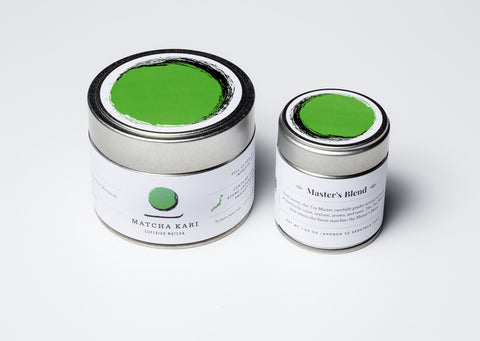
PROCESSING (STONE-GRINDING)
Perhaps a final differentiator between traditional matcha is the way it’s processed to a powder. Industrial tea farms use a high-powered blender which creates heat and oxidizes (ruins) the tea, whereas true ceremonial matcha is ground with stone-milling.
This allows a microscopic, fine powder without causing damage to the nutrients or health benefits.
- This type of grinding can produce matcha at the rate of only 1oz per hour – where leaves are gradually funneled between the rotating stone grooves.
- Shortcuts to this process (like high power blending) means quicker processing, lower costs, but poorer quality.
- This is one of the most important reasons to avoid low-cost matcha, which relies on industrial methods to reduce that processing time.
If you’re not sure whether your matcha is stone-ground, try placing some powder on a piece of paper. Slowly draw a finger through the powder and across the page. If there are any larger particles or unsmooth markings on the paper, your matcha is most likely not stoneground.
That means you could be missing out on those critical health compounds and overall having a lesser matcha experience than you deserve.

How to Find Premium Ceremonial Matcha
It’s easy to feel lost in the huge growth of matcha interest lately. Even after a lot of research there still might be a lot of intricacies. Perhaps the toughest is to select a grade of matcha for your needs and find a great source for it.
With a couple of key pointers, you’ll have the knowledge you need to select the perfect matcha for your taste buds, health, and your wallet. Here are 5 of the most important ways to identify high-quality matcha:
Color
Don’t always trust the label. If you have a chance to inspect the color of the powder inside the tin beforehand, do it! It’s easy for matcha to be edited to be more vibrant than the actual powder inside, so if you’re concerned with this, here’s a couple of tips.
What Color should Matcha Be?
Look for a deeply bright green color for your matcha. Imagine an emerald hue and try to match it to the matcha available to you. The relationship between vibrant color and quality is a reliable one for matcha.
- It allows you to make a good judgment about the concentration of vitamins, minerals, and health optimizing compounds.
- By judging by color you can also be certain to avoid 2nd or 3rd flush matcha.
Unlike first-harvest (i.e. first-flush) matcha, those are qualities with greater bitterness, yellowed green color, and reduced health benefits. That’s because this tea comes from plants stressed into multiple harvests each year, significantly reducing the levels of nutrients and healthy phyto-compounds.
Usually, that is tea intended only for baking, since it is low cost and ‘ok’ when balanced with other flavors. Yet for the average person, it’s not ideal.
HOW MATCHA SHOULD FEEL
Besides color, the feel of matcha is a big indicator of quality. That can mean a couple of things, such as how it feels between your fingers, and any apparent texture or clumping. Here are the full details:
If the color is agreeable, and you notice any dense looking clumps, that’s another good sign. That’s because the clumping is an indicator of fresh matcha, the powder that has not been overly exposed to the elements or oxidized.
- The clumping happens because of the fine particle size, which creates static electricity.
- Fresher matcha has more visible clumping and is intended to be sifted with a traditional sieve.
- Old matcha or industrially powdered matcha will appear dry with very loose powder that does not stick to your finger.
How to Test Matcha
If you get the chance, rub a very small amount between your fingers to get a sense of the moisture and freshness of the powder. If it has a buttery, hydrated feel, that’s good!
However, if it feels very dry, dusty, or quickly falls from your finger, rather than mostly sticking, then your matcha may be inauthentic, or have been improperly stored. As you become more familiar these extra senses become second nature, but they can really make the difference for newcomers!
How to get Matcha to Froth?
Believe it or not, the traditional accessories used to prepare matcha can mean a big difference in how it froths. Besides a sifter to prevent clumping, one of the most important things is having a bamboo whisk (chasen), or a more modern, battery-powered one.
The traditional whisk used in the Japanese Tea Ceremony is made from a single piece of bamboo, really an elegant example of craftsmanship. It’s also great to learn how to use it in developing a super layer of froth, and many enjoy it as part of their daily matcha ritual.
- Once you get the ‘zig-zag,’ back-and-forth motion of whisking under your belt, with high-quality matcha you should have a thick foamy layer of froth.
- And if it doesn’t? You likely have a quality issue.
Since with a low grade of matcha, the actual chemical composition will be different. Low-grade matcha has less protein and amino acids which together help create froth [9]. Those amino acids are what give matcha the calming benefits [1,3], especially the L-theanine.
So, if your matcha isn’t frothing, that means you’re getting less of those healthy benefits. No matter how hard you whisk low-grade matcha, the result will be the same: dull color and taste, without that characteristic and delicious froth.

Do you Sip Matcha? Do you Slurp it?
Premium quality matcha should work for you and make it easy to reach a slurp-friendly froth. The bubbles should be very small and appear tightly uniform.
- Any larger bubbles are considered rude during the traditional Tea Ceremony, a convention that may have originated due to the connection with poor froth with bad quality matcha.
In fact, it’s considered ‘good behavior’ to slurp your matcha. Mixing air into each sip creates a more complex experience of flavor. Give it a try!
When is Matcha Ready to Drink?
The appearance of good froth means the matcha is ready to be enjoyed. It means that the healthy compounds in the tea have been activated and dissolved in water – since matcha is able to be better absorbed than other teas [10] – these benefits are ready to fuel your health, hustle, and overall wellness.
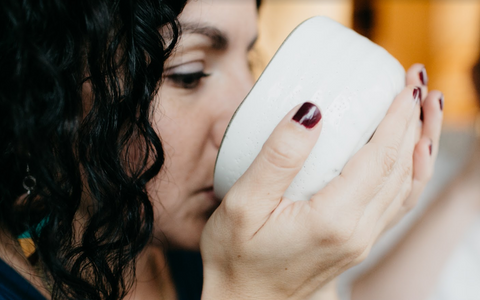
Cost of Matcha Tea, is it Worth it?
This is an important point. If you notice matcha being marketed as ‘premium quality’ or ‘ceremonial grade’ but the cost is substantially lower than other price-points you’ve seen, don’t buy it – literally.
A number of matcha products on the market are taking advantage of the lack of customer education and experience with this previously unknown tea. With a cost that’s too good to be true, you’re guaranteed to run into the poor taste, ‘lack of froth’, and other distasteful characteristics.
- It also means you might be choosing matcha sourced from China or elsewhere. These are imitations of the real deal.
Only Japan can produce matcha since they have nearly 1,000 years of experience creating it. And other green tea powders from China and even Kenya are reported to contain levels of heavy metals and pesticides; this includes “white matcha” – is it really a thing? No, it’s not.
Is Matcha Worth it?
Even matcha grown in Japan is being labeled as a higher grade than it actually is. Sometimes a culinary grade (meant for baking) is marketed as ‘premium’ or ‘ceremonial grade.’ Since matcha is new many people are none the wiser.
So, the bottom line is that matcha is extremely labor-intensive to produce in the premium quality, and there is no way to get around those costs.
- Mid-grade sipping matcha may start around $1.00/gram, so if you’ve noticed a product at a lower cost, you’re going to be stuck with culinary matcha.
- Or worse, you could be walking into imitation matcha.
FLAVOR OF MATCHA | How to make matcha tea
Finally, besides color, feel and froth, and cost, the flavor is also a trustworthy indicator of quality. The tea plants used to produce matcha are unlike regular green tea because they have been specially bred for centuries to have the right balance of flavors, benefits, and composition.
One of those details is the umami of the tea, in other words the savory flavor:
Umami Matcha
In the culinary world, the sense of savoriness is also referred to as the fifth-flavor, i.e. “umami”. The simple translation of umami is ‘pleasant taste,’ as the flavor, we enjoy with soups, aged cheeses, truffles, and broths. It turns out that that flavor is essential, literally, to the chemical balance of health benefits that people seek in premium, thick tea matcha.
That’s first because the driving reason for drinking tea is the antioxidants. It turns out that these natural compounds, very popularly EGCG, are the reason behind the bitterness of the tea.
- To balance the bitterness of these flavonoids (catechins, polyphenol), the savory amino acids offer a complex, intense, and full flavor experience.
- Highest levels of savory flavor is found in premium-quality matcha, ensuring a palatable flavor so you can consume more antioxidants without the bitter taste.
L-theanine, The Savory Matcha Compound
Geography and climate also play important roles in the balance of these flavors. Matcha grows under special shaded conditions to achieve improved tenderness and nutrient density.
The umami amino acid in matcha, L-theanine, is owed to this change of composition and is one of the strongest correlations between quality and cost.
L-theanine works immediately in our taste-buds, and even begins working directly in the brain after drinking matcha! It’s closely related to glutamate, an essential amino-acid present in meats and cheeses [1-3].
Because of the chemical similarity, it shares in that savory effect, though acting very differently on a physiological level.
- It’s also the secret behind matcha’s role in Zen meditation.
In fact, matcha is nature’s most concentrated source of that special amino acid, where it synergizes with natural caffeine. The combination piques a serene alertness, and wow – you can really feel it!
- This synergy is associated with neuro-regulatory properties and improved alpha-waves in the brain [8].
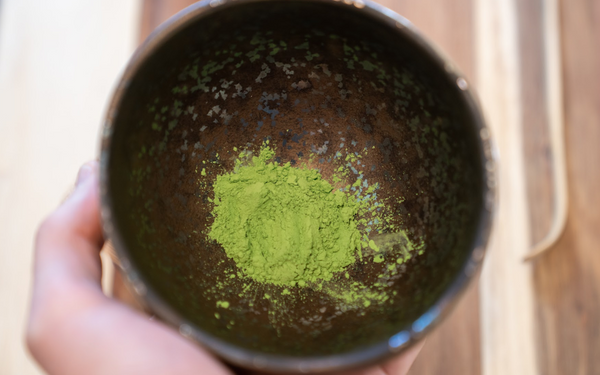
Is Premium Matcha Really Better?
No one wants to overspend on something if the quality isn’t there, or if the benefits don’t justify the costs. When someone sees the potential price differences between two matcha products, it’s even tougher not to be skeptical.
It’s true that the highest quality of matcha is costlier than you’d first anticipate. But there is an essential reason behind it. But first, more importantly, at the higher range of costs (low-grade matcha to premium grade), there is significantly more flavor – and health benefits.
While it’s tempting to chalk the higher-cost up to a marketing ploy, the ancient history of matcha begs to differ. It comes down to a laborious process to produce matcha that is densely nutritious, full of amino acids, and rich in antioxidants.
SELECTING A HIGH-QUALITY SOURCE OF MATCHA
Within 15-20 minutes of drinking a bowl of high-quality matcha, you begin to feel a calm, laser-focused source of clarity rise up within you. If you’ve tried matcha and didn’t get this effect, then it’s safe to assume you had a bitter, poorly grown (possibly imitation) grade of matcha.
Do your health the favor of starting from scratch with the real-deal, and you’ll have all the context you need to continue navigating the expansive world of matcha!
Does Harvest Season Affect Matcha Quality?
When you’re searching for a quality source of matcha, remember that like most crops, matcha has a prime season. And if you’re searching for the highest quality of premium matcha green tea, then you need to look for matcha harvested in the Spring-time.
- Spring is the season that the ‘first-flush’ of matcha is hand-harvested in Japan.
- In light of demand for matcha, more tea-farms are cultivating a second or third-flush towards the end of the Summertime.
- These leaves will also produce more tannins, causing a yellowed color and bitter flavor.
These have a purpose in culinary recipes but rarely in any type of drinking – even lattes. Any leaves harvested in the Summer would be reduced in nutrient content, and poor in flavor.
First-Flush Matcha | Green Matcha Tea
These later in the year harvest also tend to stress the plants, causing damage and reducing their ability to yield premium quality.International demand from corporate chains places pressure on Japan’s tea farms to produce more with those extra flushes of harvest.
Overall, this is a dire fact in the mission to preserve this long line of tradition and amazing health benefits. That’s why the search for high quality should also represent a commitment to support those tea-farms fighting to maintain this amazing health drink.
Keeping it safe from pressures to use unsafe fertilizers or pesticides, or resort to other forms of cutting-corners. Besides, when you choose a great quality matcha tea, you’ll have something you enjoy drinking on a daily basis.
Health Benefits of Matcha Green Tea
Evidence about the health benefits of matcha and other green-tea dates back for thousands of years. Any preparation of tea-leaf from the C. Sinensis plants will contain certain levels of polyphenols, antioxidants, and other compounds good for health.
In fact, some of the earliest records of human civilization are found with evidence of tea-drinking. And for millennia the brewing of tea has been part of many cultures’ daily practices. With so much history, many benefits have long been associated with green tea, such as in Traditional Chinese Medicine.
- One example which has been believed for millennia is that green-tea is a longevity-promoter.
- It’s also been thought for centuries to prevent disease, improve healing, and elevate natural immunity, and bolster cognitive health.
Reports aside, today we know that many of those long-held benefits are true, or rooted in substantial evidence [1-10]. While not a miracle cure, nor approved to treat illnesses, researchers continue to put matcha green tea to the test in clinical studies.
Some exciting avenues include anti-cancer research, anti-diabetic, anti-depressant, and as a preventative against cardiovascular disease [11-16].
- You can check out our health benefits resource page. Or, continue reading for some of the newest and most exciting health possibilities of matcha.
Surprising Health Benefits of Matcha
Every day there are more compelling reasons to enjoy a daily bowl of matcha. Many of today’s prescription drugs originated as plant-compounds, and in the hunt for new drug treatments, researchers frequently look first for natural remedies – like green tea and adaptogens – which possess a history of natural health benefits.
In the case of matcha green tea, it’s a particularly welcomed subject because of its ancient place in medicine. The special cultivation of matcha from fresh green tea leaves is also now understood as essential: preserving the highest natural levels of specialized health compounds.
Matcha has a long list of potential uses in health, superior to regular green or black teas since the full essence is consumed [10]. Besides savory flavor, that means maximal benefits for wellness:
MATCHA GREEN TEA PROTECTS YOUR HEART
The polyphenols and catechin antioxidants in matcha have been established by numerous research studies to promote a healthy heart. These natural antioxidants are reported to lower blood pressure, reduce bad cholesterol including VLDL, and reduce oxidative stressors associated with good heart health [11-16].
It’s interesting that when you drink matcha, the polyphenols come in contact with your blood vessels and help them relax, known as vasodilation [11-13]. This gives your cardiovascular system a much-needed break and is the same basic physiological change that people experience in exercise and sauna therapies.
MATCHA GREEN TEA IS AN EXERCISE MIMETIC
Daily drinking of matcha green tea is associated with many of the same benefits you’d expect from a regular exercise routine. Including those positive effects for heart health, this natural detoxifier also mimics the metabolic changes like increased ketogenesis, glucose response, and autophagy [17-23].
Research states that people who consume matcha develop a higher basal-metabolism [4, 6, 20-23].
- In other words, they are burning more calories.
- This is one of the most prized, natural effects of matcha, and most recently it has been researched as part of new evidence for weight-loss.
Since matcha green tea may help eliminate imbalances in metabolism, you may be able to avoid some of the inflammatory pathways associated with things like glucose spikes and weight gain, possible benefits include maintaining a healthy BMI and lessening risks of heart disease [14-23].
- By acting similarly to the benefits of exercise, matcha green tea may also extend to cognitive longevity [18-25].
MATCHA GREEN TEA DURING A FAST
Green tea is reported as a measure behind improved metabolism. One detail explaining this is elevated ketone synthesis – also called ketogenesis – this is the way our bodies evolved to survive with limited food.

Ketogenesis becomes stronger during times of starvation and limited caloric intake. This hormonal change also is known to trigger a cascade of longevity-promoting changes, like autophagy and stem-cell activation [17], and researchers are now beginning to understand how this happens at a cellular level, and where green tea may play into these natural cycles.
Autophagy is one example where the body has a system to revitalize our cells, but it needs the right activation. The ‘biohacking’ communities are taking note of green tea since it may amplify the benefits of a fasted state, without forcing the individual to truly undergo starvation.
- Important since there are side effects to going too long without food [17].
Researchers are keen on any natural and safe method to bridge that balance Ultimately, matcha may be a key means behind supporting your autophagic metabolism, in-hand with intermittent fasting, and helpful in finding that balance without interrupting ketogenesis.
- A plain serving of matcha does not have any carbohydrates
MATCHA GREEN TEA HELPS YOUR MUSCLES
Matcha green tea is an example of a daily adaptogen that helps achieve our goals with less strain on our busy routines and stress levels [16]. It’s the perfect primer to maximizing our resilience with regular practices of exercise and diet and may be able to help achieve a better workout, with less time [18-23].
- It’s suggested that green tea supplementation can improve glycogen replenishment [26], so you can achieve more workout with less rest time.
It may also protect against burning muscle to fuel workouts because it regulates the metabolism of both ketogenesis and gluconeogenesis, so your muscles have energy available from both sides [22-23].
- As you achieve better workouts, the antioxidants in matcha may help recoveries because they get between healthy cells and free radicals produced during exercise [24-25].
DOES MATCHA TEA HELP YOU WORKOUT?
For those already in the habit of a regular exercise routine, matcha is reported to achieve greater levels of peak cardiac output. And for those more casual, one study found that women who had one cup of matcha tea before a 30-minute walk elevated fat burning levels.
- This applied to exercise which resulted in an elevated heart rate of more than 50% of resting [27], telling us that matcha can have impressive effects, even with lighter forms of exercise!
MATCHA TEA SUPPORTS BRAIN HEALTH
If you’re worried about your cognitive health, or mental longevity, matcha might be the friend you’re looking for. Recent findings evaluated the compounds in matcha and found they are able to cross the blood-brain barrier (BBB) [28-29].
Antioxidants like EGCG and the unique amino-acid L-theanine are examples that may permeate into the brain. These friendly molecules act directly on our neurochemistry and may help with levels of serotonin, dopamine, and other neurotransmitters.

- High quality, premium matcha is known to contain higher amounts of calming amino acids [10], which are associated with possible reductions to depression, anxiety, and other symptoms.
- Also, matcha is a great switch from coffee and other energy drinks, which may otherwise cause jitters or to feel anxious or over-stimulated [30].
MATCHA CAN REPLACE UNHEALTHY ENERGY DRINKS
You can make the switch to matcha, a friendly form of caffeine, by starting with a single serving and sipping over 15 minutes or so. As you learn to love how it makes you feel, you should be able to replace other unfavored energy drinks in your life. You may also notice you need less caffeine.
Unlike other natural sources of caffeine that do not contain L-theanine, matcha does. People often report this synergy with caffeine helps them work harder, stay more productive, and not feel as affected by the energizing effects when it comes time for sleep [1-3, 30].
- The synergy between caffeine and L-theanine is also studied to improve reaction time, memory, and learning when compared to control groups.
HELPS WITH MOOD, FOCUS, AND MEDITATION
Speaking of synergy, the antioxidants in matcha such as polyphenols and flavonoids may be able to influence mood or improve meditation [28]. This also extends to the special amino-acids in matcha which may help balance an overactive brain [1-3, 30].
As for L-theanine, (a special amino acid in matcha) it has a chemical similarity to the amino-acid known as glutamate. Glutamate is our brain’s most abundant neurotransmitter.
- L-theanine is a similar molecule to glutamate, it may help control for overactivity in the brain, including in diets where too much glutamate is associated with anxiety or headaches.
- L-theanine also promotes alpha-brain waves, the key to relaxation.
- Ideal serving size is reported around 200mg, which would be hard to get without matcha.
Another surprising brain boosting property of matcha is its probiotic properties, but the reason might surprise you. The antioxidants help our gut bacteria to act in healthy ways, to promote the ‘good bacteria’ to help us synthesize the right nutrients [31].
- This effect may cover the family of bacteria known as lactobacilli. They produce ‘lactate’ which is able to cross into the brain (similar to exercise) and improve cognitive health and mood.
This is an important means of cognitive longevity outside the direct antioxidant and antiinflammatory benefits of matcha green tea and the brain [32-36].
PROTECTS FROM ENVIRONMENTAL TOXINS
More people are learning the importance of minimizing daily exposure to toxins and other environmental contaminants. Sometimes our level of exposure is called ‘toxic-load’ and the higher your load, the greater risks to your health. Here, matcha may play part in a healthy approach.
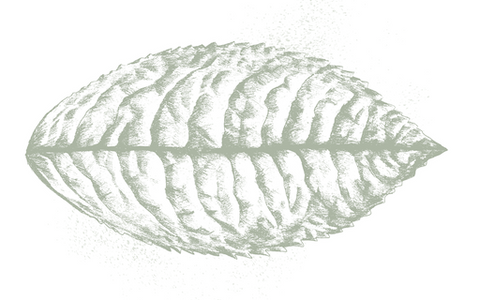
Fortunately, there are a couple easy things you can do to make a huge difference. Things like drinking filtered water, eating organic vegetables, and choosing personal products that are made with natural ingredients.
- These are examples of how you can cut down on your exposure levels, but there are also ways you can help your body excrete those toxins you can’t avoid.
Matcha green tea is widely reported to ‘ramp-up’ your body’s natural detoxification process. In practice, this works because the potent antioxidants in green tea may be able to bind to cellular debris such as free radicals [24-25].
This can help your body get rid of them, while the anti-inflammatory and nutritional benefits of matcha will help your natural detoxification process work as healthily as possible.
- This mostly means offering daily support to your detox organs including kidneys and liver.
THE BEST NATURAL DETOX
In fact, real ‘detoxes’ are few and far between. But the cleansing and therapeutic properties of matcha tea are practical examples of how we can give our bodies the best shot at health. It can help our kidneys work more efficiently, and give the liver more powerful antioxidants to work with to eliminate toxins.
Matcha also has other compounds that can improve our response to foreign contaminants. Diverse phytochemicals like chlorophyll, tannins, and polyphenols are an entourage of good-for-you compounds that may offer cellular protection against free radicals [10, 24-25, 31-35].
Is Matcha Higher in Antioxidants than other Teas?
Matcha has higher levels of key antioxidants compared to other teas, including the green tea you find in average tea bags. Much of this is to do with the way it’s grown. Careful cultivation means that the tea plants have the energy to switch gears towards those helpful, healthy compounds.
Antioxidants in Matcha
The composition of antioxidants in matcha tea is different from more common brewed teas, like black or pu-erh. These are subject to oxidation and fermentation processes which causes chemical changes and may reduce the concentration of desired antioxidants.
The process of preserving matcha means that all essential compounds are saved until they are enjoyed. This is good because matcha also contains the highest concentrations of catechin antioxidants – you get the benefits of each of them.
TYPES OF ANTIOXIDANTS IN MATCHA
Specifically, matcha is known to have five major catechins: catechin, epicatechin, epicatechin-3-gallate, epigallocatechin, and epigallocatechin gallate [10]. Each of these has special actions in the body that may offer health protections.
Shade-grown matcha also has antioxidant activities from flavonoids like quercetin, myricetin, and kaempferol. Traditional harvest also means prized phenolics like ferulic, chlorogenic, and gallic acids – each reported with anti-viral, immune-boosting, or antioxidant actions. [10, 24-25, 32]
When you drink matcha, in some cases you're ingesting more than 100 times the concentration of those compounds than standard green tea [10].
Matcha’s ORAC Rating
One of the biggest drivers of green tea’s popularity in the past decades is the high antioxidants. Big findings mark the antioxidants in green tea as potential anti-cancer and immune-boosting. But how does it really stack up against other types of food?
ORAC (OXYGEN RADICAL ABSORBANCE CAPACITY) OF MATCHA GREEN TEA:
- Dark chocolate contains 227 units
- Pecans have 180; walnuts 135
- Pomegranates 105, and wild berries, acai berries, broccoli and other greens less than 100
And matcha? It contains nearly 1,400 ORAC units per serving. But perhaps even more intriguing, the helpful compounds in matcha may also tell our bodies to create more natural antioxidant defenses [37].
That includes increased levels of glutathione, a potent ‘endogenous’ (made by the body) antioxidant. And since matcha is more easily absorbed than green tea, because of the fine powder, that means your body may get these benefits without any interference [38].
How Matcha Green Tea is Enjoyed Today
By the early 1500s, the enjoyment of this ceremonial tea had spread to the political and royal arenas of Japanese society. Yet between then and until a couple of decades before now, it only grew more deeply into each edge of Japan, without leaping too successfully internationally.
Only in very recent years has it made it off the shores of Japan, especially in the last 5 years. Interest has skyrocketed into virtually every corner of the world as countless new people are introduced to it daily. It’s working wonders for health, hustle, and happiness across the world – in the U.S. and beyond!
Matcha Internationally | Canada Matcha, Global Matcha
Matcha has become versatile beyond the traditional tea ceremony. So, as modern travel opened up international communities, matcha is now improving daily routines across the world.
It may still be prepared in ceremonial fashion in Japan, but the emphasis of a daily practice of Tea Ceremony is no more. Some say there’s simply no time for it, while others internationally might find it boring or too slow-paced.
Fortunately, modern preparations are springing from left and right.
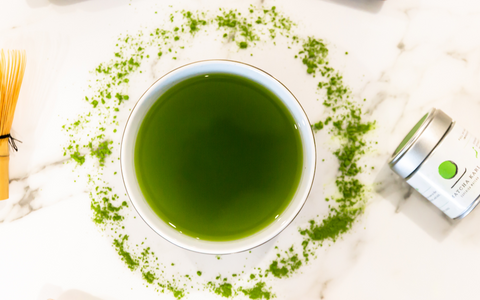
MATCHA IN THE UNITED STATES
From here in the U.S, this rare form of tea has grown massively. Matcha’s audience ranges from older people looking for an edge in longevity and health in those later ages, all the way to the millennial generation.
Exotic recipes and coffee equivalents are now status quo at your local specialty cafe, and even the big-box chains too (beware of the quality).
- Recipes are craftier than ever to incorporate it into adaptogen tonics, and even Matcha Golden Milk Lattes.
Generations young and old, the spiritual and mindful aspect has translated to modern practices of yoga, meditation, and a variety of different fitness studios.
- Exercise regimens now host matcha in part of mindfulness, and mental perspective, relating to how it influences their health and outlook.
Perhaps, it’s the ‘newest’ yet most ancient health move. Matcha offers good vibes and helps tackle health physically and mentally in a new and exciting way that speaks to your body in a way that you’ll love.
WISE AND HEALTHY FOOD CHOICES
An important driver of matcha’s success state-side also has to do with the popularity of organic products and healthy food choices, like the anti-inflammatory diet. This holds true across all age groups, now as people are more educated than ever on the value of balanced nutrition.
- Old remedies and traditional foods are having a renaissance and matcha is on the forefront.
- Besides a trustworthy, time-vetted history, it’s full of vitamins and minerals.
- It’s also a near-complete source of amino-acid building blocks[1, 3, 9]. Wow!
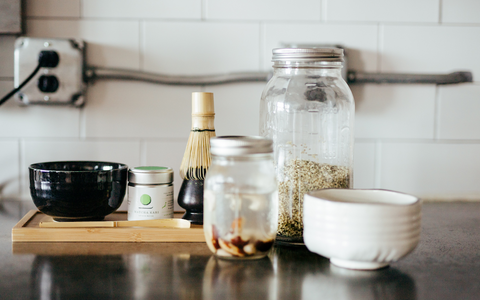
Fortunately, matcha also rises to the challenge of one of the most critical crossroads for people conscious of diet. Those with resolve for a pure, safe, toxin-free diet are able to find themselves at home with matcha.
- In fact, a few of Japan’s most prized tea farms now offer matcha in both traditional and USDA Organic quality. Review the differences here.
Is Organic Important for Matcha? How to make Organic Matcha
The short answer: it depends. This is different for every person, and matcha is one example in which people want the very best information to make a decision. It’s also surprising to learn that it’s not as cut-and-dry of a choice as deciding on Organic produce.
Overall, the topic of organic matcha is complicated. Japan is a world leader in agricultural and land purity, many of its regulations stricter by default than those of USDA Organic certification.
- Matcha that is cultivated on the few remaining, safely, authentically maintained tea-farms is reported to have the highest standard of purity which is beyond USDA Organic standards.
Important Differences between Organic and Non-Organic Matcha
Despite a working relationship of Organic certification reciprocity between the U.S. and Japan (see JONA – Japanese Organic Certifying Body), the traditional fertilizers used to cultivate matcha do not typically meet those standards.
Mind you, these are the same, pure sources of soil nutrients that have been used for centuries by traditional tea-growers. Huge strides in organic agriculture are being made in the U.S, Japan, and other countries around the world.
That means greater flexibility to meet organic standards, without sacrificing quality, but is most difficult to accomplish with matcha compared to other crops.
CEREMONIAL ORGANIC MATCHA?
As of now, organic quality matcha is only scratching the surface of premium Ceremonial Grade Matcha. In fact, only recently have traditional cultivation techniques been able to merge with organic standards.
- One example of this is Tenchi Ceremonial Organic Matcha, our special blend of matcha – demonstrating state of the art organic soil fertilization – while maintaining the desirable characteristics of ceremonial quality.
- This type of matcha is extremely rare, and even more limited in annual supply.

So what happens with a simple search online for “ceremonial organic matcha”? Dozens of results, how? It comes down to grading and marketing:
HOW MATCHA IS GRADED | Picking a Matcha
The quality of matcha is determined by the tea-master, which will blend, or select a single cultivar for processing to a final tea. Though once the matcha is packaged and distributed to international buyers, there are no regulations about how the tea may be labeled.
This has caused a great deal of misinformation, and less reputable brands take little time educating about how they’ve arrived at a certain name for their tea.
- What’s labeled as ‘ceremonial organic’ matcha may, in fact, be an organic matcha, but a culinary (low) grade.
- This ploy allows cheap matcha to be sold at a premium price point to unsuspecting newcomers.
- Also the term ‘organic’ aside, the term ‘ceremonial’ is similarly thrown around with short regard.
In Japan, the use of ‘ceremonial’ terms are held with strict guidelines. To help out, you can use our color guide to pick out true ceremonial quality matcha.
- Or check out more of the steps behind ceremonial grade matcha, for insights to avoid low-grade and bitter matcha teas.
How to Read the Label with Matcha Green Tea
Matcha is growing popular by the day in coffee shops and specialty cafes. There are concerns of added sugar content in any matcha that is prepared for you, but many matcha powders you can buy at the store ALSO contain added sugar.
Here we review tricks to be careful for, and also how to choose matcha based on your needs for organic or non-organic products. First, it’s most important to know the source of your matcha.
- That is regardless of whether you’re ordering matcha at a cafe, or buying to make at home – be cautious!
Country of Origin for Matcha
Country of origin should always read Japan, with no mention of other national locales for manufacturing. Be careful of possible tricks:
- Example: “Packaged in Japan.” This may be a trick, in which case you should look harder for the detail, “Made in ____”. That’s because an influx of “Made in China” matcha is trying to pass as the real deal.
Imitation matcha may also come from countries in Africa, but in the case of ‘made-to-order’ matcha drinks, it’s rare a cafe will have the product label on display.
That makes determining the source tough, and the ingredient list even more so.
For matcha powder purchased retail for your at-home use, at least here you will have the chance to inspect the label. Watch out for alternative names for added sugar (examples below) or suspicious or overzealous health claims.
- Big claims might include the use of words like “proven, to treat, cure” and others.
- Green tea (especially matcha) has a lot of potential – but there should be no presence of absolute claims like those.
How to Spot Added Sugar in Matcha
If you’re keen for an authentic matcha experience, then stay vigilant about the label and any additives, artificial sweeteners, emulsifiers, or preservatives. Tricky names or ‘approved alternatives’ for sugar are especially tough to stay the wiser.
- To make things easy, look for “100% Matcha Green Tea Powder”. If there are additives, they typically are milk powder, maltodextrin (sugar), or preservatives.
- Also good to know: milk proteins found in blended matcha mixes are known to reduce the antioxidant benefits.

Certain additives might come down to preference, but sugar more often than not is there to offset poor quality and hide the bitter bite of low-grade matcha.
HIDDEN NAMES FOR SUGAR
According to WebMD, labels may obscure sugar content under these pseudonyms:
- “Brown sugar, corn sweetener, corn syrup, dextrose, fructose, glucose, high-fructose corn syrup, honey, lactose, malt syrup, maltose, molasses, raw sugar or sucrose.”
If you see any of these names for sugar on your matcha label, then you might be looking at an impostor.
Check if Your Matcha is USDA Organic
Matcha has exploded with interest during a time that people are also more concerned about potential pesticides in their produce. Many products have made strides to become USDA Organic certified, and now there are matcha products on the market which have that guarantee.
You can read about the tricky differences with our article comparing organic to non-organic matcha. However, if you’re set on an organic selection, be sure to practice careful label reading as you make your selection:
- Any organic certified product should carry the USDA Organic symbol (usually a green-colored seal) to support any claims about this qualification.
- This license is highly regulated to protect against pesticides – but remember – it doesn’t mean anything about true ceremonial quality.
Yes, you read that right. Organic does NOT always mean higher quality. That said, there is great tasting organic matcha available. Be sure to trust your eyes, your taste buds, and your gut.
- Poor quality will cast a brown or yellowed hue of green, with bitter taste which can also cause stomach irritation – a common question for newcomers to matcha.
Ways to Prepare Matcha | Making Matcha
With the recent surge of matcha interest, there are more ways than ever to find a ‘way to matcha,’ and even quizzes to help you Get MATCHA’ed. You’ll find the right fit for your lifestyle and health goals.
But what about ways to prepare it?
Popular examples are desserts like ice cream, sweet lattes, or dalgona recipes. But there’s also equal curiosity about traditional preparation. That means matcha which is enjoyed as a hot drink, plain with water.
Here, there are two ways to prepare it, depending on the grade of matcha:
- ‘Koicha’ (i.e. Thick Tea)
- ‘Usucha’ (i.e. Thin Tea)
Thick tea
Thick tea is synonymous with Ceremonial Grade, which offers enjoyable flavor in a more concentrated tea (almost syrupy). Whereas thin tea uses less matcha to water ratio, literally a thinner preparation.
- Both styles may be prepared with a set of traditional accessories.
Difference between Thick Tea and Thin Tea
The experience of great-tasting matcha requires you to be mindful of what type of matcha you have, and how it was intended to be prepared and enjoyed. For example, the lowest cost options are a culinary grade of matcha – neither thick or thin tea – and not meant for drinking plain.
- You wouldn’t want to use this matcha to drink because the bitterness would be overwhelming.
- Thin tea (usucha) would only be bitter if prepared as a syrupy, thick drink – requiring extra water to balance natural flavors.
- And good quality thick tea – no matter how you prepare it – will have no bitterness and is always full of savory, sweet flavor. The ultimate source of health benefits.
So, what are the recommendations to prepare each type?
Preparing Matcha
For any drinking matcha, you’ll always want to sift the matcha first. Bring water to a simmer (170F) and place the sifter (furui) over your mixing bowl as you press the fresh powder through.
- For usucha/thin tea – Add about 70ml (~1/3cup) of hot water to the sifted powder
- For koicha/thick tea – Add use 50ml (~1/4cup) of hot water
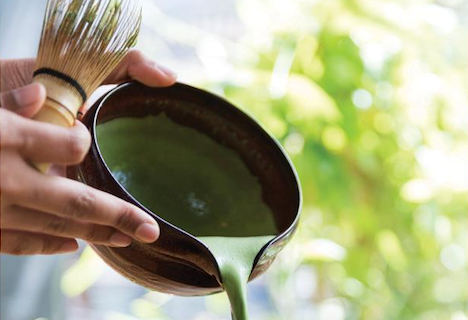
Regarding temperature, the ideal water temperature is right between 170-173 °F, thought to extract all the healthy compounds (and caffeine) without damaging, or ‘burning’ the matcha.
Whisking Matcha
Both thick and thin tea are whisked in the same manner using a bamboo piece (chasen). Once your water and matcha powder have been added, slowly run the utensil across the bottom of your bowl.
- At this point, begin quick strokes in an ‘M’ or ‘W’ shape, where each stroke is slightly raised off the bottom of the bowl.
The froth will begin to develop, where you may continue the motion as you bring the whisk closer and closer out of the tea. In this way, you will create a uniform froth, without larger bubbles.
It’s best to consume within 3-5 minutes of preparation so that the froth does not dissipate, and that the tea is not left exposed for too long. The strong antioxidants absorb oxygen from both inside, and outside the body – so be courteous to the tea not to wait too long in consuming it.
Sipping Matcha
Traditional matcha is prepared in the morning and enjoyed on an empty or light stomach. The caffeine content makes it a superior energizer ahead of your day’s activities, and most people are able to tolerate the tea without an upset stomach.
- That said, everyone is different and some do report sensitivity or passive nausea. If you experience this, try having a bit of food or waiting an extra hour into the day before enjoying it.
This will give your stomach the chance to better acclimate to the matcha tea while allowing you to fully enjoy the benefits.

In Conclusion
People are enthusiastic about finding a new type of daily fuel that doesn’t give them that coffee crash, and one which doesn’t dull their energy later in the day either.
Matcha is perhaps the newest (yet oldest) energy drink known to the planet. It has long served Zen monks, the Samurai, and fueled centuries of healthy lifestyles in Japan. Now... it has come to you!
Choosing your matcha lifestyle wisely should be of utmost importance, especially since everyone has different needs, different tastes, and variable expectations for potential health benefits and energizing properties.
A comprehensive scope of medical literature reminds us that many ancient claims about green tea hold true; it’s a longevity promoter, reportedly an anti-inflammatory, and may be able to improve your mental outlook as well as long-term cognitive health.
Key Takeaways
It’s a way of staying grounded and giving a moment of gratitude each day. It packs a punch of amazing health compounds (antioxidants, L-theanine, vitamins, and minerals) and represents an accessible means of enjoyment for health and spirit.
People are even using it as a ‘pre’ and ‘post-workout,’ with growing research on how it can help our muscles stay strong, and reduce recovery time.
It may also be an energizer before meditation, and most exciting, finding a simple and effective replacement for their current choice of energy.
The Bottom Line: Is Matcha Right for Me?
So, no matter what your hustle is, or what it demands of you physically or mentally, matcha is a reliable way of getting more out of your day and feeling resilient as you accomplish amazing things.
By being educated in this intriguing world, we’re able to be wary of quality in how it relates to our health and energy, while equally important we can be sure to support the tea farms who need us most.
Sourcing the most authentic matcha means an amazing source of daily energy, and a means of dedication to this long tradition at risk of being lost. There’s only 5 dozen tea-farms left in Japan producing true Ceremonial Grade matcha – will you help us support them?
-Team Matcha Kari
* * *
Quiz: Get MATCHA’ed ~or~ SHOP TRUE MATCHA?
References
[1] Camfield, D. A., Stough, C., Farrimond, J., & Scholey, A. B. (2014). Acute effects of tea constituents L-theanine, caffeine, and epigallocatechin gallate on cognitive function and mood: a systematic review and meta-analysis. Nutrition reviews, 72(8), 507-522.[2] Farzaei, M. H., Bahramsoltani, R., Abbasabadi, Z., Braidy, N., & Nabavi, S. M. (2019). Role of green tea catechins in prevention of age‐related cognitive decline: Pharmacological targets and clinical perspective. Journal of cellular physiology, 234(3), 2447-2459.
[3] Kakuda, T. (2011). Neuroprotective effects of theanine and its preventive effects on cognitive dysfunction. Pharmacological research, 64(2), 162-168
[4] Zhou, J., Mao, L., Xu, P., & Wang, Y. (2018). Effects of (−)-Epigallocatechin Gallate (EGCG) on Energy Expenditure and Microglia-Mediated Hypothalamic Inflammation in Mice Fed a High-Fat Diet. Nutrients, 10(11), 1681.
[5] Gianfredi, V., Nucci, D., Abalsamo, A., Acito, M., Villarini, M., Moretti, M., & Realdon, S. (2018). Green tea consumption and risk of breast cancer and recurrence—A systematic review and meta-analysis of observational studies. Nutrients, 10(12), 1886.
[6] Lin, Y., Shi, D., Su, B., Wei, J., Găman, M. A., Sedanur Macit, M., ... & Guimaraes, N. S. (2020). The effect of green tea supplementation on obesity: A systematic review and dose–response meta‐analysis of randomized controlled trials. Phytotherapy Research
[7] Faria, A., Pestana, D., Teixeira, D., Couraud, P. O., Romero, I., Weksler, B., ... & Calhau, C. (2011). Insights into the putative catechin and epicatechin transport across blood-brain barrier. Food & function, 2(1), 39-44.
[8] Kelly, S. P., Gomez-Ramirez, M., Montesi, J. L., & Foxe, J. J. (2008). L-theanine and caffeine in combination affect human cognition as evidenced by oscillatory alpha-band activity and attention task performance. The Journal of nutrition, 138(8), 1572S-1577S.
[9] Koláčková, T., Kolofiková, K., Sytařová, I., Snopek, L., Sumczynski, D., & Orsavová, J. (2020). Matcha tea: Analysis of nutritional composition, phenolics and antioxidant activity. Plant Foods for Human Nutrition, 75(1), 48-53.
[10] Powell, J., & Thompson, R. H. (1998). In vitro mineral availability from digested tea: a rich dietary source of manganese. Analyst, 123(8), 1721-1724.
[11] Lorenz, M., Urban, J., Engelhardt, U., Baumann, G., Stangl, K., & Stangl, V. (2009). Green and black tea are equally potent stimuli of NO production and vasodilation: new insights into tea ingredients involved. Basic research in cardiology, 104(1), 100-110.
[12] Mattson, M. P., & Wan, R. (2005). Beneficial effects of intermittent fasting and caloric restriction on the cardiovascular and cerebrovascular systems. The Journal of nutritional biochemistry, 16(3), 129-137.
[13] Sugita, M., Kapoor, M. P., Nishimura, A., & Okubo, T. (2016). Influence of green tea catechins on oxidative stress metabolites at rest and during exercise in healthy humans. Nutrition, 32(3), 321-331.
[14] Khalesi, S., Sun, J., Buys, N., Jamshidi, A., Nikbakht-Nasrabadi, E., & Khosravi-Boroujeni, H. (2014). Green tea catechins and blood pressure: a systematic review and meta-analysis of randomised controlled trials. European journal of nutrition, 53(6), 1299-1311.
[15] Lorenz, M., et al. (2004). A constituent of green tea, epigallocatechin-3-gallate, activates endothelial nitric oxide synthase by a phosphatidylinositol-3-OH-kinase-, cAMP-dependent protein kinase-, and Akt-dependent pathway and leads to endothelial-dependent vasorelaxation. Journal of Biological Chemistry, 279(7), 6190-6195.
[16] Zeka, K., Ruparelia, K., Arroo, R. R., Budriesi, R., & Micucci, M. (2017). Flavonoids and their metabolites: prevention in cardiovascular diseases and diabetes. Diseases, 5(3), 19.
[17] Salemi, S., Yousefi, S., Constantinescu, M. A., Fey, M. F., & Simon, H. U. (2012). Autophagy is required for self-renewal and differentiation of adult human stem cells. Cell research, 22(2), 432-435.
[18] Imaizumi, K. (2011). Effect of endurance training supplemented with green tea extract on substrate metabolism during exercise in humans. Scandinavian journal of medicine & science in sports, 21(4), 598-605.
[19] Jówko, E. (2015). Green tea catechins and sport performance. In Antioxidants in sport nutrition. CRC Press/Taylor & Francis.
[20] Kang, J. (2017, April). Effects of tea polyphenols on athletes. In 2017 5th International Conference on Machinery, Materials and Computing Technology (ICMMCT 2017). Atlantis Press.
[21] Kapoor, M. P., Sugita, M., Fukuzawa, Y., & Okubo, T. (2017). Physiological effects of epigallocatechin-3-gallate (EGCG) on energy expenditure for prospective fat oxidation in humans: A systematic review and meta-analysis. The Journal of nutritional biochemistry, 43, 1-10.
[22] Machado, Á. S., da Silva, W., Souza, M. A., & Carpes, F. P. (2018). Green tea extract preserves neuromuscular activation and muscle damage markers in athletes under cumulative fatigue. Frontiers in physiology, 9.
[23] Richards, J. C., Lonac, M. C., Johnson, T. K., Schweder, M. M., & Bell, C. (2010). Epigallocatechin-3-gallate increases maximal oxygen uptake in adult humans. Medicine and science in sports and exercise, 42(4), 739.
[24] Sadowska-Krępa, E., et al (2019). Effects of medium-term green tea extract supplementation combined with CrossFit workout on blood antioxidant status and serum brain-derived neurotrophic factor in young men: a pilot study. Journal of the International Society of Sports Nutrition, 16(1), 13.
[25] Sugita, M., Kapoor, M. P., Nishimura, A., & Okubo, T. (2016). Influence of green tea catechins on oxidative stress metabolites at rest and during exercise in healthy humans. Nutrition, 32(3), 321-331.
[26] Tsai, T. W., Chang, C. C., Liao, S. F., Liao, Y. H., Hou, C. W., Tsao, J. P., & Cheng, I. S. (2017). Effect of green tea extract supplementation on glycogen replenishment in exercised human skeletal muscle. British Journal of Nutrition, 117(10), 1343-1350.
[27] Willems, M. E. T., Şahin, M. A., & Cook, M. D. (2018). Matcha green tea drinks enhance fat oxidation during brisk walking in females. International journal of sport nutrition and exercise metabolism, 28(5), 536-541.
[28]Camfield, D. A., Stough, C., Farrimond, J., & Scholey, A. B. (2014). Acute effects of tea constituents L-theanine, caffeine, and epigallocatechin gallate on cognitive function and mood: a systematic review and meta-analysis. Nutrition reviews, 72(8), 507-522.
[29] Faria, A., Pestana, D., Teixeira, D., Couraud, P. O., Romero, I., Weksler, B., ... & Calhau, C. (2011). Insights into the putative catechin and epicatechin transport across blood-brain barrier. Food & function, 2(1), 39-44.
[30] Kelly, S. P., Gomez-Ramirez, M., Montesi, J. L., & Foxe, J. J. (2008). L-theanine and caffeine in combination affect human cognition as evidenced by oscillatory alpha-band activity and attention task performance. The Journal of nutrition, 138(8), 1572S-1577S.
[31] Wu, C. Y., Su, T. Y., Wang, M. Y., Yang, S. F., Mar, K., & Hung, S. L. (2018). Inhibitory effects of tea catechin epigallocatechin-3-gallate against biofilms formed from Streptococcus mutans and a probiotic lactobacillus strain. Archives of oral biology, 94, 69-77.
[32] Farzaei, M. H., Bahramsoltani, R., Abbasabadi, Z., Braidy, N., & Nabavi, S. M. (2019). Role of green tea catechins in prevention of age‐related cognitive decline: Pharmacological targets and clinical perspective. Journal of cellular physiology, 234(3), 2447-2459.
[33] Wightman, E. L., Haskell, C. F., Forster, J. S., Veasey, R. C., & Kennedy, D. O. (2012). Epigallocatechin gallate, cerebral blood flow parameters, cognitive performance and mood in healthy humans: a double‐blind, placebo‐controlled, crossover investigation. Human Psychopharmacology: Clinical and Experimental, 27(2), 177-186.
[34] Kakuda, T. (2011). Neuroprotective effects of theanine and its preventive effects on cognitive dysfunction. Pharmacological research, 64(2), 162-168
[35] Pervin, M., Unno, K., Ohishi, T., Tanabe, H., Miyoshi, N., & Nakamura, Y. (2018). Beneficial effects of green tea catechins on neurodegenerative diseases. Molecules, 23(6), 1297.
[36] Wightman, E. L., Haskell, C. F., Forster, J. S., Veasey, R. C., & Kennedy, D. O. (2012). Epigallocatechin gallate, cerebral blood flow parameters, cognitive performance and mood in healthy humans: a double‐blind, placebo‐controlled, crossover investigation. Human Psychopharmacology: Clinical and Experimental, 27(2), 177-186.
[37] Basu, A., Betts, N. M., Mulugeta, A., Tong, C., Newman, E., & Lyons, T. J. (2013). Green tea supplementation increases glutathione and plasma antioxidant capacity in adults with the metabolic syndrome. Nutrition Research, 33(3), 180-187.
[38] Wang, J., Zareef, M., He, P., Sun, H., Chen, Q., Li, H., ... & Xu, D. (2019). Evaluation of matcha tea quality index using portable NIR spectroscopy coupled with chemometric algorithms. Journal of the Science of Food and Agriculture, 99(11), 5019-5027.





